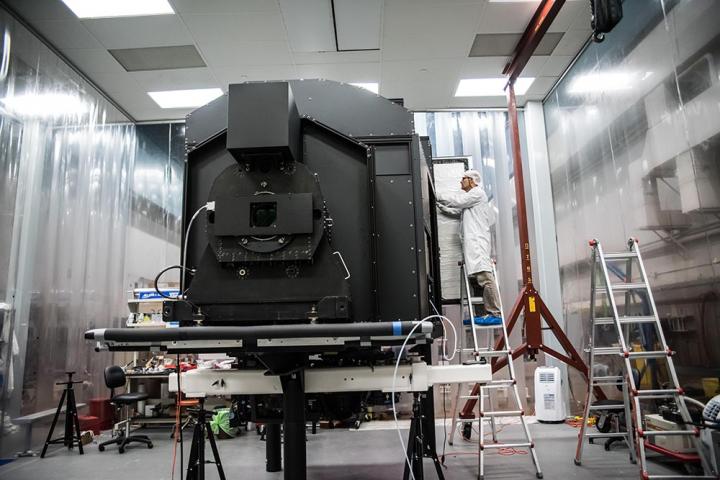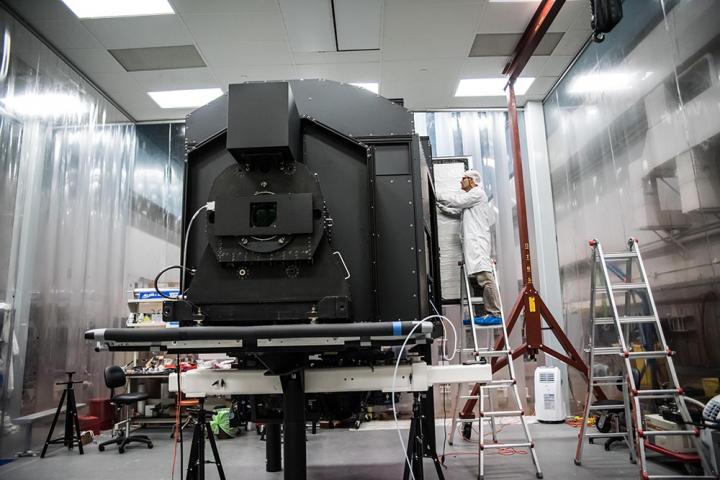
Credit: Caltech
An instrument designed to image the vast web of gas that connects galaxies in the universe has been shipped from Los Angeles to Hawaii, where it will be integrated into the W. M. Keck Observatory.
The instrument, called the Keck Cosmic Web Imager, or KCWI, was designed and built by a team at Caltech led by Professor of Physics Christopher Martin. It will be one of the best instruments in the world for taking spectral images of cosmic objects–detailed images where each pixel can be viewed in all wavelengths of visible light. Such high-resolution spectral information will enable astronomers to study the compositions, velocities, and masses of many objects, such as stars and galaxies, in ways that were not possible before.
One of KCWI's main goals, and a passion of Martin's for the past 30 years, is to answer the question: What is the gas around galaxies doing?
"For decades, astronomers have demonstrated that galaxies evolve. Now we're trying to figure out how and why," says Martin. "We know the gas around galaxies is ultimately fueling them, but it is so faint–we still haven't been able to get a close look at it and understand how this process works."
Martin and his team study what is called the cosmic web–a vast network of streams of gas between galaxies. Recently, the scientists have found evidence supporting what is called the cold flow model, in which this gas funnels into the cores of galaxies, where it condenses and forms new stars. Researchers had predicted that the gas filaments would first flow into a large ring-like structure around the galaxy before spiraling into it–exactly what Martin and his team found using the Palomar Cosmic Web Imager, a precursor to KCWI, at Caltech's Palomar Observatory near San Diego.
"We measured the kinematics, or motion, of the gas around a galaxy and found a very large rotating disk connected to a gas filament," says Martin. "It was the smoking gun for the cold flow model."
With KCWI, the researchers will get a closer look at the gas filaments and ring-like structures around galaxies that range from 10 to 12 billion light-years away, an era when our universe was roughly 2 to 4 billion years old. Not only can KCWI take more detailed pictures than the Palomar Cosmic Web Imager, it has other advances such as better mirror coatings. The combination of these improvements with the fact that KCWI is being installed at one of the twin 10-meter Keck telescopes–the world's largest observatory with some of the darkest known skies on Earth–means that KCWI will have an improved performance by more than an order of magnitude over the Palomar Cosmic Web Imager.
KCWI will map the gas flowing from the intergalactic medium–the space between galaxies–into many young galaxies, revealing, for the first time, the dominant mode of galaxy formation in the early universe. The instrument will also search for supergalactic winds from galaxies that drive gas back into the intergalactic medium. How gas flows into and out of forming galaxies is the central open question in the formation of cosmic structures.
"We designed KCWI to study very dim and diffuse objects, our main emphasis being on the wispy cosmic web and the interactions of galaxies with their surroundings," says Mateusz (Matt) Matuszewski, the instrument scientist for the project.
KCWI is also designed to be more a general-purpose instrument than the Palomar's Cosmic Web Imager, which is mainly for studies of the cosmic web. It will study everything from gas jets around young stars to the winds of dead stars and supermassive black holes and more. "The instrument is really versatile," says Matuszewski. "Observers can configure the optics to adjust the spatial and spectral scales and resolutions to suit their interests."
The nuts and bolts of KCWI
Scientists and engineers have been busy assembling the highly complex elements of the KCWI instrument at Caltech since 2012. The instrument is about the size of an ice cream truck and weighs over 4,000 kilograms. The core feature of KCWI is its ability to capture spectral information about objects, such as galaxies, across a wide image. Typically, astronomers capture spectra using instruments called spectrographs, which have narrow slit-shaped windows. The spectrograph breaks apart light from the slit into each of the colors making up the target object, just like a prism that spreads light into a rainbow. But traditional spectrographs cannot be used to capture spectral information across an entire image.
"Traditional spectrographs use multiple small slits to capture many stars or the cores of many galaxies," says Martin. "Now, we want to look at features that are extended across the sky, such as stellar jets and galaxies, which have complex structures, velocities, and gas flows. If you can only look through a slit, you can only see a small part of what is going on. But we want to see the whole picture. That's why we need an imaging spectrograph, a device that gives you an image for every single wavelength across a wide view."
To create a spectrograph that can image more extended objects like galaxies, KCWI uses what is called an integral field design, which basically divides an image up into 24 slits, and gathers all the spectral information at once.
"If you're looking at something big in the sky, it's inefficient to just have one slit and step your way across that object, so an integral field spectrograph combines a number of slit-shaped mirrors together across a continuous field of view," says Patrick Morrissey, the project scientist for KCWI who now works at JPL. "Imagine looking into a broken mirror–the reflected image is shifted around depending on the angles of the pieces. This is how the integral field spectrograph works. A series of mirrors works together to make a square-shaped stack of slits across an image appear as a single traditional vertical slit."
KCWI has the highest spectral resolution of any integral field spectrograph, which means it can better break apart the rainbow of light to see more colors, or wavelengths. The first phase of the instrument, now on its way to Keck, covers the blue side of the visible spectrum, spanning wavelength ranges from 3500 to 5600 Angstroms. A second phase, extending coverage to the red side of the spectrum, out to 10400 Angstroms, will be built next.
KCWI to Climb Mauna Kea
After KCWI arrives in Hawaii on January 18, engineers will guide it up to the top of Mauna Kea, where Keck is perched. A series of checkout and alignment tests is planned, and will be followed in a few months by the first observations through the Keck telescope.
"There are train tracks around the telescope where the instruments are installed," says Morrissey. "It's like one of those old railroad roundhouses where the train would come in and they would spin it to an available space for storage. The telescope turns around, points to the instrument that the astronomer wants to use, and then they roll that instrument on. Soon KCWI will becomes part of the telescope."
KCWI is funded by the National Science Foundation, through the Association of Universities for Research in Astronomy (AURA) program, and by the Heising-Simons Foundation, the W.M. Keck Foundation, the Caltech Division of Physics, Mathematics and Astronomy, and the Caltech Optical Observatories.
###
Media Contact
Whitney Clavin
[email protected]
626-395-1856
@caltech
http://www.caltech.edu
############
Story Source: Materials provided by Scienmag





